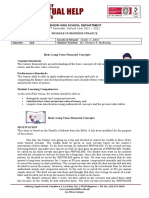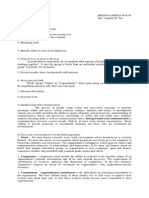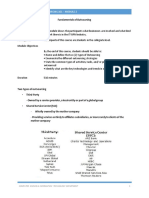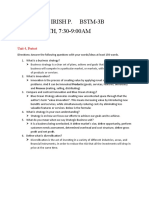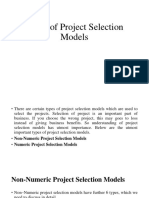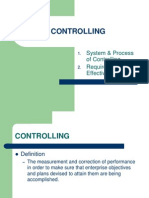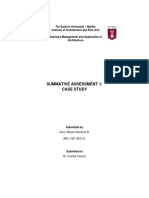DIFFERENCE BETWEEN A FUNCTIONAL MANAGER AND APROJECT MANAGER FUNCTIONAL MANAGER 1.He is in-charge of a firm’s functional depts. Such as marketing,engg., or finance.2.They are more skilled at analysis. Such heads are specialists incertain areas only.3.They are analytical in approach (breaking the system into smaller and smaller elements) and they know something abt. the operationfor which they are responsible.4.In case of any difficulty, they know how to analyze and attack it.5.They are administratively responsible for deciding how somethingwill be done, who is going to do it, and what resources will bedevoted to accomplish a task.6.He is a direct, technical supervisor.7.He should have knowledge in the technology of the process beingmanaged.8.The FM cannot allow the PM in taking control of the technicaldecisions in the functional areas or to control the assignment of thefunctional area personnel.PROJECT MANAGER 1.A PM starts his career as a specialist in some field, later on being promoted to some higher post.2.He is required to be more skilled at synthesis.3.The PM uses a system approach i.e. understanding the organizational problem, for which the project is a part, the organization for which the program exists, as well as the environment of the organization.4.The PM is a facilitator and generalist.5.He should be competent in the science of project along with havingthe technical competence in some aspects.6.He is responsible for organizing, planning, budgeting, directing, planning, and controlling the project.
Economic Analysis:
1)Economic analysis is also referred to as social cost benefitanalysis.
2)It is concerned with judging the project from a large social point of view.3)The focus is on the social costs and benefits of a project that mayoften be different from its monetary costs and benefits.4)The questions that are sought to be answered in this social cost benefit analysis are:a.What are the direct economic benefits and costs of the project measured in terms of shadow prices and not in termsof market prices? b.What would be the impact of the project on the distributionof income in the society?c.What would be the impact of the project on the level of savings and investment in the society?d.What would be the contribution of the project towards thefulfillment of certain merit wants like self-sufficiency,employment & social order?
Management Design
Design is the meaningful representation of something that is to be built. Inthe project management concept design focuses on 4 major areas:
1. Data2. Architecture3. Interfaces4. Components
Project Design is the first of the 3 technical activities that are required to build and verify the software.1. the data design transforms the informationcreated during analysis into the data structure that will be required toimplement the software. The data objects and relationship defines in the ER diagram and the detail data contents depicted in the data dictionary providesthe basis in data design activity.2. the architecture design defines therelationship between the structure elements and the design platforms that can be used to achieve the requirements that have been designed for the system.3. The interface design describes how the software communicateswith itself and the system and interface implies a flow of information and thespecific type of behavior.4. the component level design transforms thestructural elements of the software architecture into a procedural descriptionof software component.
PROJECT TERMINATION
A project is said to be terminated when work on the substance of project hasseized or slowed to the point that further progress on the project is no longer possible. Following are the types of termination:
1. Termination by extinction: The project is stopped. It may end because ithas achieved its goal. Like the new product has been developed andhanded over to the client or s/w has been installed and is running.The project may also be stopped because it is unsuccessful. For eg: If amedicine is prepared for a disease but selling at higher rate and in themarket there are other medicines at lower rate for same disease thenlaunching of this new medicine may not benefit and this project may becarried on further.2. Termination by addition: Most projects are inhouse i.e. carried out by project team for the use in parent organization. If a project is a major success it is terminated by the parent organization. For eg: Suppose theMaths dept creates a BSc[IT] course taken as a project. Now if after several years the BSc[IT] course can run on its own, then the Maths deptcan terminate this BSc[IT] project which can be considered as a fullfledged dept. now.3. Termination by intefration: This method of terminating a project is mostcommon and it is done when the complexity arises. The propertyequipment, material, personnel and functions of the project aredistributed among existing element of the parent organization. The outputof the project becomes the std. partof operating system of the parent or clientFor eg: The merger of global trust bank with oriental bank istermination by integration.Following points must be considered when the project functions aredistributed during integration.a.Personnel: Where wil the project team go? Will it remain a team.B. Manufacturing: Is the training complete? Are input materials andrequired facilities available? Are new control procedures needed.C.Accounting: Have the project accounts closed and auidited? Have the newaccounts been vreated and a/c nos been distributed.D.Engineering: Are all the drawings complete and the files complete? Havemaintenance schedule been adjusted.E. S/w or info System: Has the newsystem been throughly tested and is the s/w properly documented? Is thenew system fully integrated with current system.F. Termination bystarvation: In this type a slow starvation arises by budget decrement. Everyone involved with the project has to cope with budget cut. In some firms,for eg: they don’t want to admit the failure, so the project is continued evenif it is not fruitful. Inshort the progress has slowed down, so the companymay change the employees but the project may continue.
Q. When a project should be terminated?
A. 1. If a project is successfully completed, then it is terminated. 2.Does the project is consistant with organizational goals.3. Is the projectuseful or is it practical, if not it is terminated 4. Is the mgmt.enthusiastic about the project to support the implementation.5. Does the project represent more advance over current technology.6. Is the projectteam still inovative.7. Has the project lost its key person.
Project audit
Project audit is an examination of mgmt of a project. Its methodologies and procedures, its records, its budgets and expenditure. It may deal with the project as a whole or only the part of project. A formal report must be presented which takes the following points into account. 1. Current statusof project: Which tells that the work actually completed does match withthe plant activity. 2. Future status: Are significant schedule changeslikely if so indicate the nature of changes. 3. Status of crucial task:What progress has beeen made on task that to decide the success or failureof the project.4. Risk Assessment: Are the risk taken care of.5. Information from other project: What lessons are learned from the project autied earlier.
Depth of auditing
: To what depth the auditing should be done is decided by the organization. The factors which decide the depth of auditing are :1.Cost2. The clerical time used in conducting the audit 3. Thestorage4. The maintenance of the auditable data.The general audit is normally carried out by the qualified technicians under the direct guidance of project auditor.
Timing of audit :
1.The timing of audit will depend on the circumstances of a particular project. The first audit are usually done early in projects life. The problem isdiscovered the easier it is to deal with. Early audits often focussed on thetechnical issues inorder to make sure that the key technical problems have been solved.2. The audit done later in the life cycle of project are of less immediate value to the project but are of more value to the parentorganization. As the project develops technical issues are less likely to bethe matter of concern.3. Post project audits are conducted with several basic objectived in mind like legal necessity, feedback for manageral level,to account for all project property and expenditure.
Responsibility of project auditor:
Following steps are carried out in a audit: 1. Essentially a small team of experienced experts 2. Familiarized the team with the project.















